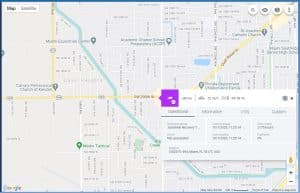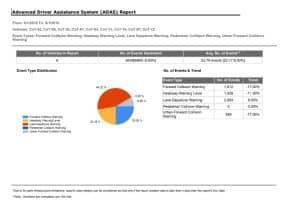
Regardless of the size of your company’s fleet, a lot of your efforts as a fleet manager will go into the maintenance of your company’s vehicles. After all, these vehicles are the primary instrument for your business to carry out its tasks and responsibilities.
Of course, that’s why you do everything in your power to make sure they’re in the best possible state – so they stay in operating condition for as long as possible, saving yourself a lot of headache in the process.
But are you proactive about it? Unlike the reactive approach that focuses on mitigating the consequences of less than optimal fleet maintenance, proactive behavior aims to anticipate and prevent problems before they arise and become larger, more time-consuming, and budget-draining.
The power to do all this successfully starts with a proper fleet maintenance program in place.
What Tasks Are Included in a Fleet Maintenance Program?
As a professional fleet manager, you probably have a pretty good idea what it entails.
But before we get into details, let’s make sure we’re on the same page by defining it in the simplest, clearest way. What exactly is fleet maintenance, by definition?
The answer is simple:
Fleet maintenance is the process of keeping your vehicles in a good operating condition for as long as possible to save time, effort, money, and ultimately, lives.
In other words: it includes all the tasks and responsibilities that fleet managers need to carry out to ensure their fleet operates like a well-oiled machine (pun intended). These include:
- organizing fleet maintenance schedules
- keeping an eye on vehicle safety
- managing repair and fuel budget

Properly organizing and conducting all these fleet maintenance tasks means your fleet will be taken care of and allowed to grow and thrive, while the job gets done quickly and efficiently. This also means tackling various challenges that may differ from what is anticipated in the vehicle manufacturer’s instructions, such as:
- different types of roads
- your drivers’ differing driving habits
- the nature of the goods you’re transporting, dictating the driving style
- various distances covered
Due to these variables, fleet managers should treat their fleet maintenance requirements as unique and rely on a comprehensive body of data to help understand them, to help them see through bias when taking into account anyone’s advice, drivers’ experience, or gut feelings.
Proper Fleet Maintenance Is Rewarding in Multiple Ways
Once you’ve brought your fleet maintenance to the highest possible level, you’ll notice a lot of things going more smoothly for you and your drivers than ever before, including in three key areas:
- Extended vehicle lifespan
- Improve your drivers’ safety
- Decrease your fleet’s overall costs
1. Extend your vehicles’ lifespan
For most fleet managers, it’s a no brainer that well-maintained vehicles stay in working condition for longer, but there are also collateral benefits of fleet maintenance that is done right? For example:
- reduced frequency of purchasing new vehicles
- less downtime when they need replacement or a fix
- fewer costs of obtaining new vehicles
In other words, it means less friction and work you need to do as the person in charge of your company’s fleet management, making your job considerably less complicated.
To make this possible, fleet managers need to stay on top of their preventive maintenance program and keep track of their fleet maintenance schedules to detect any issues that affect the vehicles’ longevity. These include regularly rotating the tires and ensuring they’re at the correct pressure, monitoring mileage, engine hours, and fuel usage so you can know when it is time for servicing.
You’ll also need to be alert of the drivers’ behavior on the road. For example, if the driver is aggressively braking and accelerating, this will cause a lot of wear and tear on the tires and brakes, so a way to monitor and correct your driver’s improper behaviors is necessary.

2. Improve your drivers’ (and everyone else’s) safety
As a fleet manager, your job isn’t just to make sure the entire operation is fast, streamlined, and cost-effective. Fleet managers also need to encourage and maintain a culture of safety when it comes to your vehicles, drivers, and even the general public.
Poorly maintained vehicles are prone to problems that might affect everyone’s safety on the road. Poor brakes and worn out tires can increase your drivers’ reaction time and braking distance, and may cause collisions, with potentially far-reaching consequences that you as the fleet manager will have to deal with.
By monitoring the condition of their vehicles for any problems, fleet managers will ensure the safety of everyone involved, directly or indirectly. In the long run, it will save them a lot of headaches – be it in terms of repairs, downtime of both vehicles AND drivers, or time and money the company would have to waste on preventable lawsuits.

3. Decrease your fleet’s overall costs
Poorly maintained vehicles can lead to repairs and expenses spiralling out of control the longer you wait, draining your fleet’s budget beyond capacity and downgrading its resale value. As a result, expenses will also increase due to missed runs and downtime caused by broken-down vehicles, which all ultimately falls down on fleet managers – the persons responsible for the fleet’s proper functioning.
Keeping a keen eye on the vehicles’ servicing needs will prevent this from happening. Consequently, you’ll be lowering both upkeeping and operational costs through preventive maintenance of your vehicles, saving your funds, and directing them to other areas where they may be more needed.
Using advanced maintenance software will allow you to create customized reports that will keep you in the know regarding the condition of every single vehicle in your fleet and prevent issues from siphoning your repairs budget. For example, you’ll be able to see which vehicles are wasting fuel, which may be indicative of an easily fixed problem.
Optimal Fleet Maintenance Relies on Meaningful Data
In the fleet management business, data can be your best friend or your worst nightmare. Why a nightmare? Because typically, fleet managers don’t properly collect or store data they have access to and end up using only a tiny fraction of it.
So what happens to the rest of the data?
The rest of it simply remains “dark”, untagged, unorganized, and therefore useless. It may also become ROT (Redundant, Obsolete, Trivial), leaving fleet managers wondering why they’re collecting it in the first place.
On the other hand, benefits of fleet maintenance management that uses a strong data-based approach include staying at least one step ahead of your peers who don’t. And the better the technology you use, the better the data you’ll get. When choosing a solution, make sure you’re going for the best option for you and not the cheapest option – it’ll turn out as the more expensive one in the end. Through successful data-powered preventive maintenance management, you can:
- gather meaningful information
- gain a bird’s view perspective of your entire fleet
- fulfill the tasks described above
- prevent issues from arising and/or spiraling out of control
- maintain a streamlined and hassle-free operation
To this end, it is important to understand what data to collect for optimal fleet maintenance and the ideal way to collect and access this data.
With a detailed overview of your fleet and its status, you’ll be able to properly organize your vehicles and workforce, stay on top of all the maintenance management and repair needs, as well as increase the health and longevity of each and every vehicle, spending both time and money in the right place.
Let’s go through these key factors:
What data to gather for optimal fleet maintenance
1. Fleet Management System (Telematics) data:
- Hard braking and acceleration:
As discussed above, aggressive driving habits like harsh braking and rapid acceleration increase the vehicle wear and tear, fuel wasting, the risk of causing damage, as well as reducing its longevity. By monitoring your driver’s behavior, you can reduce the occurrence of these aggressive habits and decrease the frequency of problems they might be causing.

- Fuel usage:
Fleet tracking and monitoring your vehicles’ fuel consumption doesn’t just allow you to stay on top of your fuel ordering schedule, but also to detect problems that might not be obvious to the naked eye. In other words, you may be able to notice consumption discrepancies that may indicate a problem with the vehicle. Observing normal fuel use will help you understand what “abnormal” use looks like and allow you to react on time before potential expenses start multiplying.

- Driver scoring (Safety; ECO):
A good vehicle maintenance platform will give you access to an extensive set of data that combines all the information on the driver’s behavior (aggressive braking and acceleration, hours of service, dash camera data, staying inside their lane, driving within the speed limit, tailgating). Based on this data, you’ll be able to rate or score the driver, allowing you to understand which drivers need more training in specific segments to reduce vehicle damage or deterioration.

2. Real-time AI video dash camera data:
Preserving a healthy fleet isn’t just about ensuring all physical parts are in good working order and anticipating their repairs. It’s also about doing your due diligence to avoid collisions and driving violations, as well as protecting brand reputation (yes – it is part of the job, if you think about it).
To this end, it is good to have a front-and-rear real-time dash camera data you can leverage to check for any distractions your driver may be experiencing, as well as irresponsible and dangerous driving (driving under influence, texting or falling asleep at the wheel). This way, you’ll save yourself a lot of hassle with the potential consequences.

3. ELD data:
- Driver hours of service
Enforced by law in most of the world, driver hours of service are monitored using an Electronic Logging Device (ELD) and can be utilized for more than just avoiding fines. This indicator can also be used to prevent vehicle damage and excessive repair costs before they happen.
Tracking your drivers’ hours of service is important as it can inform you about the risk of an accident (due to fatigue, for instance), as well as the possibility of wear and tear to the vehicle.

4. Radar-based collision prevention system data:
Through the data generated by a quality radar-based collision prevention system, you will be able to get a full overview of your fleet’s condition. As a result, it will directly help you reduce the necessity for regular maintenance tasks as it will prevent avoidable road accidents. It will also help train your drivers on the go by alerting them of lane swerving, speeding, tailgating, as well as countless other things that might push up maintenance costs.

The Ideal Way to Gather and Access Data
There is no shortage of fleet management software platforms out there that promise to provide you with relevant data. However, many of them ultimately fail to deliver anything more than simple fleet tracking as they cannot cover every aspect of your fleet’s maintenance.
Safe Drive Systems differs from the rest of the pack because it offers a rare integration between telematics, a collision prevention system, a real-time AI dash camera, ELD, and fleet management software. Through this integration, we empower fleet managers by enabling a holistic data-based approach to the fleet and its activities, using:
- a unique, bolstered set of data
- one dashboard
- real-time visibility (including inside the vehicle)
Thanks to this unparalleled combination of hardware inside the vehicle (the collision prevention system), fleet management software, ELD, and real-time AI dash cam, we can help you tackle all of your data needs in one place.
Our solutions provide you with the opportunity to maintain your fleet smoothly and effortlessly, while greatly extending its lifespan and cutting all unnecessary maintenance and operational costs.
Step up Your Fleet Maintenance Game
Are you ready to bring your fleet maintenance (and fleet management) to a whole new level, get things done more efficiently, and go home early? You’ve come to the right place. Book a free consultation with one of our advisors to evaluate your current operations and see how we can boost them together.




